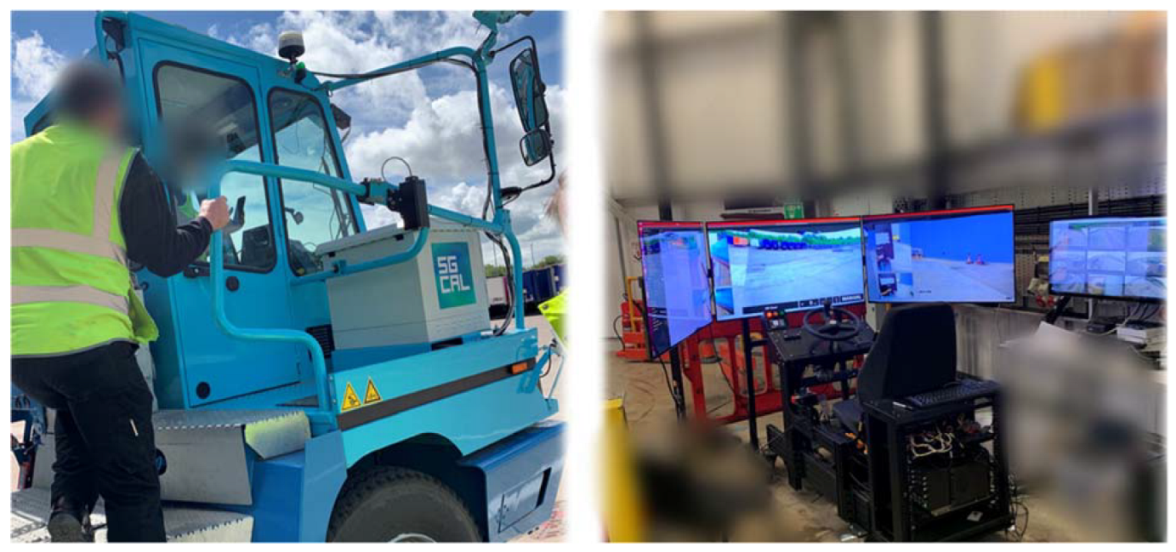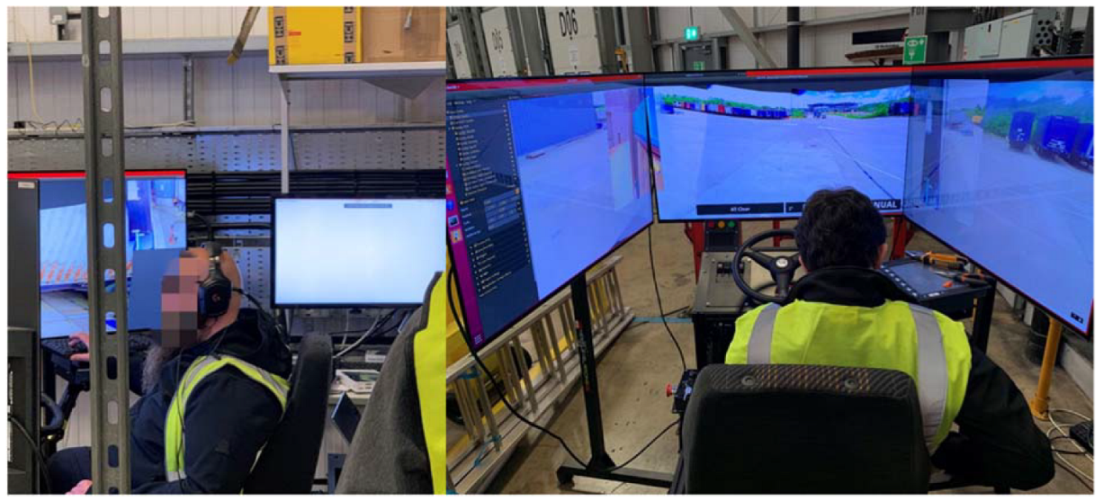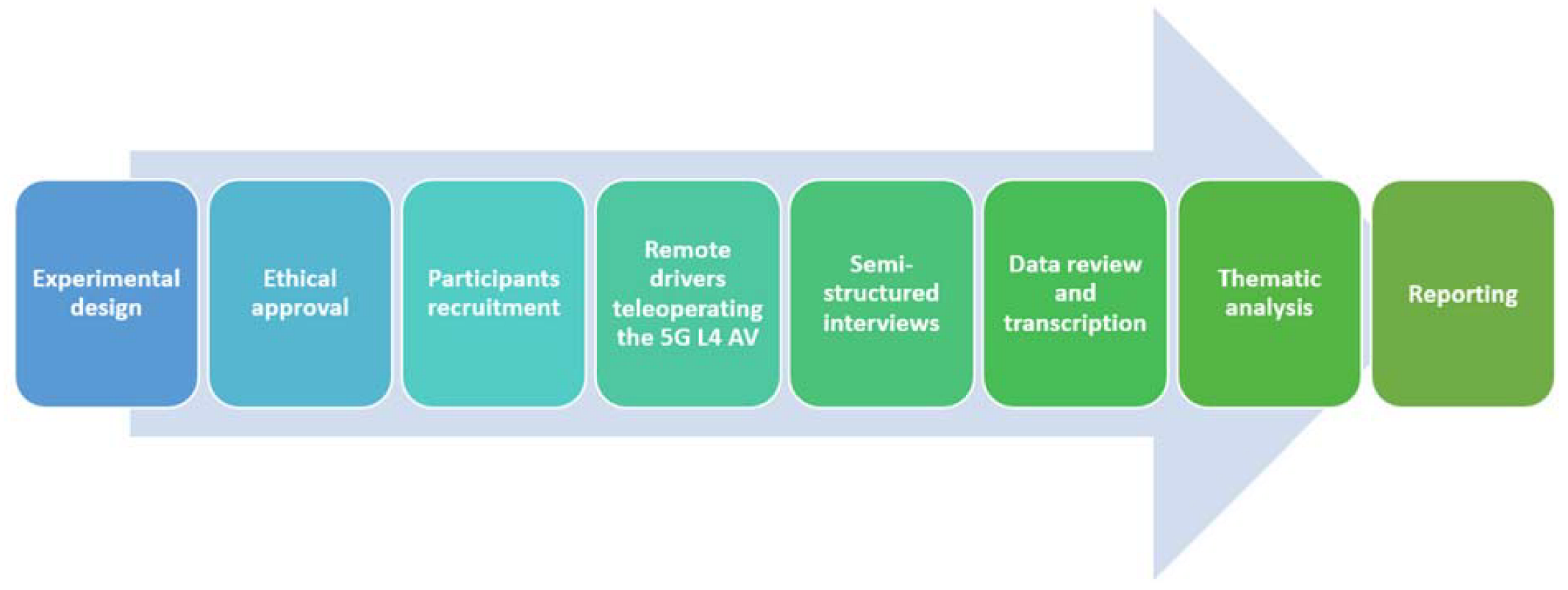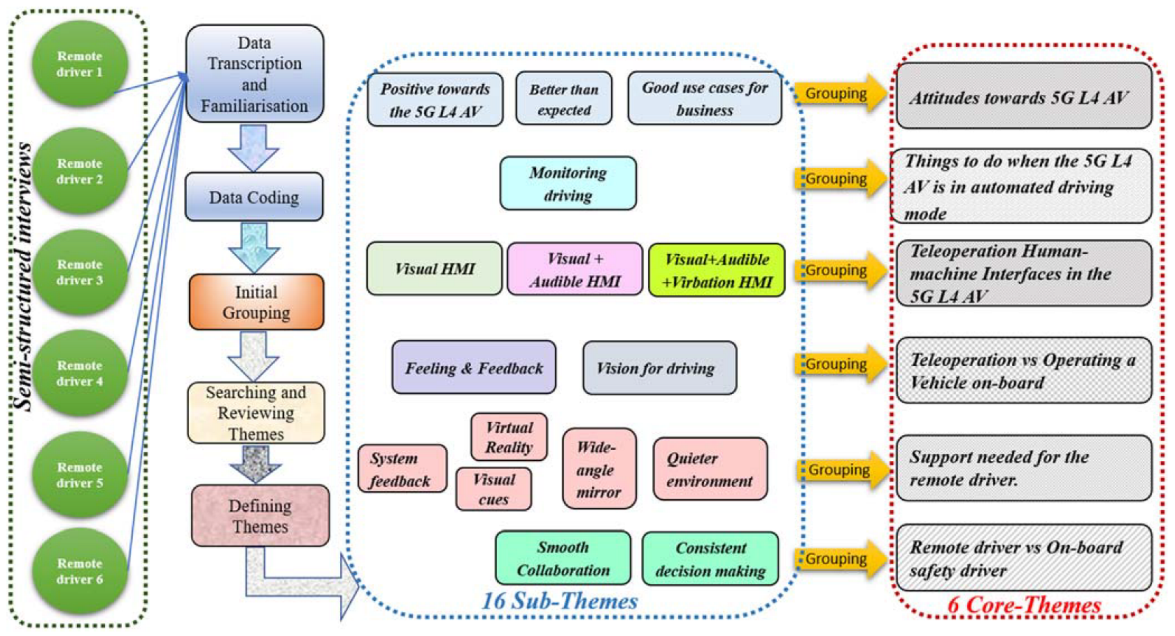Exploration into the Needs and Requirements of the Remote Driver When Teleoperating the 5G-Enabled Level 4 Automated Vehicle in the Real World—A Case Study of 5G Connected and Automated Logistics
Abstract
1. Introduction
1.1. State of the Art and Research Gaps
- There is limited research regarding the deployment and evaluation of full-scale authentic automated vehicles incorporating a teleoperation solution in the real world.
- Existing research regarding the teleoperation or remote operation of vehicle automaton has neglected one of the most essential elements of the teleoperation system—the remote drivers (operators).
- Understanding the acceptance, perception and requirements of support from the remote driver’s perspective is important to design and develop safe, effective and user-friendly teleoperation systems for automated vehicles. However, knowledge regarding the needs and requirements of remote drivers when interacting with automated vehicles is limited.
1.2. Purpose of the Research
2. Materials and Methods
2.1. The 5G-Enabled Level 4 Automated Vehicle
2.2. Participants
2.3. Study Design
2.4. Qualitative Data Collection
- What is your general opinion of the Level 4 automated vehicle?
- If you are sitting on the remote-control workstation and the vehicle is performing automated driving, what would you do?
- How would you prefer to be informed about a remote-control request of the automated vehicle?
- What are the differences and similarities between operating the vehicle on-board and remotely?
- When performing the remote control of the automated vehicle, what difficulties have you encountered?
- When you are performing the remote control of the automated vehicle, what support do you need?
- Do you have any recommendations to the original equipment manufacturers (in terms of vehicle design and remote-control workstation design)?
2.5. Research Process
3. Results and Discussion
3.1. Summary of the Thematic Analysis
3.2. Theme 1: Attitudes towards the 5G L4 AV
3.3. Theme 2: Things to Do When the 5G L4 AV Is in Automated Driving Mode
3.4. Theme 3: Teleoperation Human–Machine Interfaces in the 5G L4 AV
3.5. Theme 4: Teleoperation vs. Operating a Vehicle On-Board
3.6. Theme 5: Support Needed for the Remote Driver
3.7. Theme 6: Remote Driver vs. On-Board Safety Driver
4. Conclusions and Future Work
- Remote drivers have positive attitudes towards the 5G L4 AV.
- Remote drivers would be monitoring the road when the 5G L4 LV is performing automated driving. They expect to be informed if something happens.
- In terms of the human–machine interface, remote drivers would like to have verbal communication if there is a safety driver on-board. If there were no safety drivers on board (ultimately the desired scenario), a visual, audible and vibrational HMI would be beneficial.
- The main difference and difficulties remote drivers experienced when controlling the vehicle remotely (compared to conventional manual driving) was lack of depth vision, as well as not being able to feel the feedback from the vehicle when executing a manoeuvre.
- Remote drivers would like more support regarding their visual field driving when teleoperating the 5G L4 AV.
- Remote drivers would like more support in terms of enhancing the perception of physical feedback when teleoperating the 5G L4 AV.
- Possible support includes introducing Virtual Reality, wide angle mirrors, as well as full motion feedback systems into the teleoperation workstation of the 5G L4 AV.
- Remote drivers collaborated smoothly with the on-board safety driver, and their strategic decision making in urgent situations was consistent with the on-board safety drivers’.
Author Contributions
Funding
Institutional Review Board Statement
Informed Consent Statement
Data Availability Statement
Conflicts of Interest
References
- Shladover, S.E. Connected and automated vehicle systems: Introduction and overview. J. Intell. Transp. Syst. 2018, 22, 190–200. [Google Scholar] [CrossRef]
- Taiebat, M.; Brown, A.L.; Safford, H.R.; Qu, S.; Xu, M. A review on energy, environmental, and sustainability implications of connected and automated vehicles. Environ. Sci. Technol. 2018, 52, 11449–11465. [Google Scholar] [CrossRef] [PubMed]
- Vahidi, A.; Sciarretta, A. Energy saving potentials of connected and automated vehicles. Transp. Res. Part C Emerg. 2018, 95, 822–843. [Google Scholar] [CrossRef]
- Sohrabi, S.; Khodadadi, A.; Mousavi, S.M.; Dadashova, B.; Lord, D. Quantifying the automated vehicle safety performance: A scoping review of the literature, evaluation of methods, and directions for future research. Accid. Anal. Prev. 2021, 152, 106003. [Google Scholar] [CrossRef] [PubMed]
- Mavromatis, I.; Tassi, A.; Piechocki, R.J.; Sooriyabandara, M. On urban traffic flow benefits of connected and automated vehicles. In Proceedings of the IEEE 91st Vehicular Technology Conference (VTC2020-Spring), Antwerp, Belgium, 25–28 May 2020. [Google Scholar]
- Li, S.; Blythe, P.; Zhang, Y.; Edwards, S.; Xing, J.; Guo, W.; Ji, Y.; Goodman, P.; Namdeo, A. Should older people be considered a homogeneous group when interacting with level 3 automated vehicles? Transp. Res. Part F Traffic Psychol. Behav. 2021, 78, 446–465. [Google Scholar] [CrossRef]
- Li, S.; Blythe, P.; Zhang, Y.; Edwards, S.; Guo, W.; Ji, Y.; Goodman, P.; Hill, G.; Namdeo, A. Analysing the effect of gender on the human–machine interaction in level 3 automated vehicles. Sci. Rep. 2022, 12, 11645. [Google Scholar] [CrossRef]
- Li, S.; Blythe, P.; Guo, W.; Namdeo, A. Investigating the effects of age and disengagement in driving on driver’s takeover control performance in highly automated vehicles. Transp. Plan. Technol. 2019, 42, 470–497. [Google Scholar] [CrossRef]
- SAE. Taxonomy and Definitions for Terms Related to Driving Automation Systems for On-Road Motor Vehicles. 2016. Available online: https://www.sae.org/standards/content/j3016_202104/ (accessed on 1 August 2021).
- Li, S.; Blythe, P.; Guo, W.; Namdeo, A. Investigation of older driver’s takeover performance in highly automated vehicles in adverse weather conditions. IET Intell. Transp. Syst. 2018, 12, 1157–1165. [Google Scholar] [CrossRef]
- Li, S.; Blythe, P.; Guo, W.; Namdeo, A.; Edwards, S.; Goodman, P.; Hill, G. Evaluation of the effects of age-friendly human-machine interfaces on the driver’s takeover performance in highly automated vehicles. Transp. Res. Part F Traffic Psychol. Behav. 2019, 67, 78–100. [Google Scholar] [CrossRef]
- Li, S.; Blythe, P.; Edwards, S.; Goodman, P.; Hill, G. Investigation of the influence of multitasking on drivers’ takeover performance in highly automated vehicles. In Proceedings of the 26th Intelligent Transport Systems World Congress, Singapore, 21–25 October 2019. [Google Scholar]
- Peng, Q.; Iwaki, S. Visual Attention of Young and Older Drivers in Takeover Tasks of Highly Automated Driving. In Proceedings of the International Conference on Human-Computer Interaction, Copenhagen, Denmark, 19–24 July 2020; pp. 210–221. [Google Scholar]
- Favarò, F.M.; Seewald, P.; Scholtes, M.; Eurich, S. Quality of control takeover following disengagements in semi-automated vehicles. Transp. Res. Part F Traffic Psychol. Behav. 2019, 64, 196–212. [Google Scholar] [CrossRef]
- Vom Dorff, S.; Böddeker, B.; Kneissl, M.; Fränzle, M. A fail-safe architecture for automated driving. In Proceedings of the 2020 Design, Automation & Test in Europe Conference & Exhibition (DATE), Grenoble, France, 9–13 March 2020; pp. 828–833. [Google Scholar]
- Kettwich, C.; Schrank, A.; Oehl, M. Teleoperation of highly automated vehicles in public transport: User-centered design of a human-machine interface for remote-operation and its expert usability evaluation. Multimodal Technol. Interact. 2021, 5, 26. [Google Scholar] [CrossRef]
- Marquez-Barja, J.M.; Hadiwardoyo, S.; Lannoo, B.; Vandenberghe, W.; Kenis, E.; Deckers, L.; Campodonico, M.C.; dos Santos, K.; Kusumakar, R.; Klepper, M.; et al. Enhanced teleoperated transport and logistics: A 5g cross-border use case. In Proceedings of the 2021 Joint European Conference on Networks and Communications & 6G Summit (EuCNC/6G Summit), Porto, Portugal, 8–11 June 2021; pp. 229–234. [Google Scholar]
- Goodall, N. Non-technological challenges for the remote operation of automated vehicles. Transp. Res. Part A Policy Pract. 2020, 142, 14–26. [Google Scholar] [CrossRef]
- Majstorović, D.; Hoffmann, S.; Pfab, F.; Schimpe, A.; Wolf, M.M.; Diermeyer, F. Survey on Teleoperation Concepts for Automated Vehicles. In Proceedings of the 2022 IEEE International Conference on Systems, Man, and Cybernetics (SMC), Prague, Czech Republic, 9–12 October 2022; pp. 1290–1296. [Google Scholar]
- Bogdoll, D.; Orf, S.; Töttel, L.; Zöllner, J.M. Taxonomy and Survey on Remote Human Input Systems for Driving Automation Systems. In Proceedings of the Future of Information and Communication Conference, San Francisco, CA, USA, 3–4 March 2022. [Google Scholar]
- Zulqarnain, S.Q.; Lee, S. Selecting Remote Driving Locations for Latency Sensitive Reliable Tele-Operation. Appl. Sci. 2021, 11, 9799. [Google Scholar] [CrossRef]
- Li, S.; Edwards, S.; Isik, M.O.; Zhang, Y.; Blythe, P.T. Qualitative Examination of Cooperative-Intelligent Transportation Systems in Cities to Facilitate Large-Scale Future Deployment. Sensors 2022, 22, 8423. [Google Scholar] [CrossRef]
- Li, S.; Blythe, P.; Guo, W.; Namdeo, A. Investigation of older drivers’ requirements of the human-machine interaction in highly automated vehicles. Transp. Res. Part F Traffic Psychol. Behav. 2019, 62, 546–563. [Google Scholar] [CrossRef]
- Harrell, M.C.; Bradley, M.A. Data Collection Methods. Semi-Structured Interviews and Focus Groups; National Defense Research Institute: Santa Monica, CA, USA, 2009; Available online: http://www.dtic.mil/docs/citations/ADA512853 (accessed on 5 December 2022).
- Braun, V.; Clarke, V. Using thematic analysis in psychology. Qual. Res. Psychol. 2006, 3, 77–101. [Google Scholar] [CrossRef]
- Merat, N.; Madigan, R.; Nordhoff, S. Human factors, user requirements, and user acceptance of ride-sharing in automated vehicles. In Proceedings of the International Transport Forum, Leipzig, Germany, 31 May–2 June 2017. [Google Scholar]
- Cunningham, M.L.; Regan, M.A. Driver distraction and inattention in the realm of automated driving. IET Intell. Transp. Syst. 2018, 12, 407–413. [Google Scholar] [CrossRef]
- Saxby, D.J.; Matthews, G.; Warm, J.S.; Hitchcock, E.M.; Neubauer, C. Active and passive fatigue in simulated driving: Discriminating styles of workload regulation and their safety impacts. J. Exp. Psychol. Appl. 2013, 19, 287. [Google Scholar] [CrossRef]
- Stevens, A.; Quimby, A.; Board, A.; Kersloot, T.; Burns, P. Design Guidelines for Safety of in-Vehicle Information Systems; Project Report PA3721/01; TRL Limited.: Crowthorne, UK, 2002. [Google Scholar]
- Naujoks, F.; Mai, C.; Neukum, A. The effect of urgency of take-over requests during highly automated driving under distraction conditions. Hum. Factors Transp. 2014, 7, 431. [Google Scholar] [CrossRef]
- De Winter, J.C.F.; Wieringa, P.A.; Dankelman, J.; Mulder, M.; Van Paassen, M.M.; De Groot, S. Driving simulator fidelity and training effectiveness. In Proceedings of the 26th European Annual Conference on Human Decision Making and Manual Control, Lyngby, Denmark, 20–22 June 2007. [Google Scholar]
- Wynne, R.A.; Beanland, V.; Salmon, P.M. Systematic review of driving simulator validation studies. Saf. Sci. 2019, 117, 138–151. [Google Scholar] [CrossRef]
- Schuemie, M.J.; Van Der Straaten, P.; Krijn, M.; Van Der Mast, C.A. Research on presence in virtual reality: A survey. CyberPsychol. Behav. 2001, 4, 183–201. [Google Scholar] [CrossRef] [PubMed]
- Kaspi, M.; Raviv, T.; Ulmer, M.W. Directions for future research on urban mobility and city logistics. Networks 2022, 79, 253–263. [Google Scholar] [CrossRef]
- Cornet, H.; Stadler, S.; Kong, P.; Marinkovic, G.; Frenkler, F.; Sathikh, P.M. User-centred design of autonomous mobility for public transportation in Singapore. Transp. Res. Proc. 2019, 41, 191–203. [Google Scholar] [CrossRef]
- Zhang, Y.; Li, S.; Blythe, P.; Edwards, S.; Guo, W.; Ji, Y.; Xing, J.; Goodman, P.; Hill, G. Attention Pedestrians Ahead: Evaluating User Acceptance and Perceptions of a Cooperative Intelligent Transportation System-Warning System for Pedestrians. Sustainability 2022, 14, 2787. [Google Scholar] [CrossRef]
- Polit, D.F.; Beck, C.T. Generalization in quantitative and qualitative research: Myths and strategies. Int. J. Nurs. Stud. 2010, 47, 1451–1458. [Google Scholar] [CrossRef]
- Blythe, P.T.; Sharples, S. Science Plan: The Vision for Science in DfT. 2021. Available online: https://assets.publishing.service.gov.uk/government/uploads/system/uploads/attachment_data/file/1009520/science-plan-the-vision-for-science-in-dft.pdf (accessed on 5 December 2022).




| Theme 1: Attitudes towards the 5G L4 AV | |
|---|---|
| Sub Themes | Example Quotes |
| 1.1 Positive towards the 5G L4 AV |
|
| 1.2 Better than expected |
|
| 1.3 Good use cases for business |
|
| Theme 2: Things to Do When the 5G L4 AV Is Automated Driving | |
|---|---|
| Sub Themes | Example Quotes |
| 2.1 Monitoring driving |
|
| Theme 3: Teleoperation Human–Machine Interfaces in the 5G L4 AV | |
|---|---|
| Sub Themes | Example Quotes |
| 3.1 Visual HMI |
|
| 3.2 Visual + Audible HMI |
|
| 3.3 Visual + Audible + Vibration HMI |
|
| Theme 4: Teleoperation vs. Operating a Vehicle On-Board | |
|---|---|
| Sub Themes | Example Quotes |
| 4.1 Feeling and Feedback |
|
| 4.2 Vision for driving |
|
| Theme 5: Support Needed for the Remote Driver | |
|---|---|
| Sub Themes | Example Quotes |
| 5.1 System feedback |
|
| 5.2 Virtual reality |
|
| 5.3 Visual cues |
|
| 5.4 Wide angle mirror |
|
| 5.5 Quieter environment |
|
| Theme 6: Remote Driver vs. On-Board Safety Driver | |
|---|---|
| Sub Themes | Example Quotes |
| 6.1 Smooth collaboration |
|
| 6.2 Consistent decision making |
|
Disclaimer/Publisher’s Note: The statements, opinions and data contained in all publications are solely those of the individual author(s) and contributor(s) and not of MDPI and/or the editor(s). MDPI and/or the editor(s) disclaim responsibility for any injury to people or property resulting from any ideas, methods, instructions or products referred to in the content. |
© 2023 by the authors. Licensee MDPI, Basel, Switzerland. This article is an open access article distributed under the terms and conditions of the Creative Commons Attribution (CC BY) license (https://creativecommons.org/licenses/by/4.0/).
Share and Cite
Li, S.; Zhang, Y.; Edwards, S.; Blythe, P.T. Exploration into the Needs and Requirements of the Remote Driver When Teleoperating the 5G-Enabled Level 4 Automated Vehicle in the Real World—A Case Study of 5G Connected and Automated Logistics. Sensors 2023, 23, 820. https://doi.org/10.3390/s23020820
Li S, Zhang Y, Edwards S, Blythe PT. Exploration into the Needs and Requirements of the Remote Driver When Teleoperating the 5G-Enabled Level 4 Automated Vehicle in the Real World—A Case Study of 5G Connected and Automated Logistics. Sensors. 2023; 23(2):820. https://doi.org/10.3390/s23020820
Chicago/Turabian StyleLi, Shuo, Yanghanzi Zhang, Simon Edwards, and Philip T. Blythe. 2023. "Exploration into the Needs and Requirements of the Remote Driver When Teleoperating the 5G-Enabled Level 4 Automated Vehicle in the Real World—A Case Study of 5G Connected and Automated Logistics" Sensors 23, no. 2: 820. https://doi.org/10.3390/s23020820
APA StyleLi, S., Zhang, Y., Edwards, S., & Blythe, P. T. (2023). Exploration into the Needs and Requirements of the Remote Driver When Teleoperating the 5G-Enabled Level 4 Automated Vehicle in the Real World—A Case Study of 5G Connected and Automated Logistics. Sensors, 23(2), 820. https://doi.org/10.3390/s23020820








